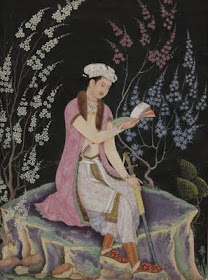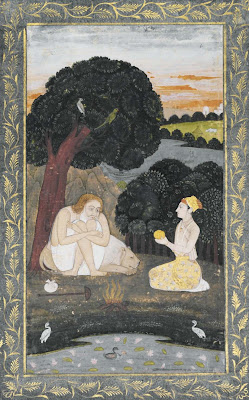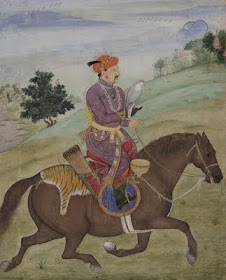These two Safavid Persian paintings depicts Mary (Maryam) and Jesus (ʿĪsā), as indicated by the inscriptions. They date to the late eleventh century AH / seventeenth CE and are attributable to the Safavid painter Shaykh ‘Abbāsī, whose works range between 1060 AH / 1650 CE to 1095 AH / 1683-4 CE.
Saturday, December 17, 2011
Monday, December 5, 2011
Friday, November 25, 2011
Thursday, November 10, 2011
Saturday, November 5, 2011
Monday, October 31, 2011
Saturday, October 15, 2011
Friday, October 14, 2011
Monday, October 10, 2011
Sunday, October 2, 2011
Wednesday, September 28, 2011
Monday, September 26, 2011
Thursday, September 22, 2011
Art Gallery of New South Wales
I visited the AGNSW and discovered that several wonderful Indian miniatures have been gifted to the Gallery recently. Here are some images from the gallery website.
www.artgallery.nsw miniatures
www.artgallery.nsw miniatures
Tuesday, September 20, 2011
Saturday, September 17, 2011
Tuesday, September 13, 2011
Sunday, September 11, 2011
Thursday, September 8, 2011
Wednesday, September 7, 2011
Youth Reading
The influence of Persian miniature painting is evident in this work from the Bodleian Library collection.
The dark background has been used to set off the sprays of blossom.
Sunday, September 4, 2011
Thursday, September 1, 2011
Outline Drawing
Today being Ganesha Chaturthi, an auspicious day in the Hindu calendar for Shri Ganesha, I decided to start a miniature painting of Shri Ganapati seated on a lotus under an umbrella.
I began with a light pencil sketch then made an outline drawing over the top with a very fine brush (3/0 size) and Winsor & Newton Indian Red watercolour (this is brownish red). I varied the weight of the brushwork lines to give the outline more energy and calligraphic quality.
Finally I used a soft eraser to remove the pencil.
I used a slightly more diluted tone for the clouds in the background, as these will be softer and vaguer than the foreground subject in the final painting.
The paper is smooth 300 GSM Arches watercolour paper, and the size of the drawing is about 150 x 150 mm. It is thick enough not to buckle too much from the moisture of the paint.
Indian miniatures usually have a border (often very ornate). Select a border that supports the image and doesn't compete with it. I've gone for a simple line border. The border lines can be ruled, but I often do them freehand in order to match the lines in the image.
Indian miniatures usually have a border (often very ornate). Select a border that supports the image and doesn't compete with it. I've gone for a simple line border. The border lines can be ruled, but I often do them freehand in order to match the lines in the image.
The outline drawing seems quite dark but It's surprising how much of this can disappear during the process of colouring. If the base drawing is too heavy it will dominate the painting, but if it is too vague then you will be less confident in completing the next stage.
Next step is to block in the main colour areas, using a bigger brush of course, without fussing with detail. I try to leave a bit of the outline showing.
I can sometimes be indecisive about which colours to chose, so I try to start with the most important elements of the subject and the colours that are fairly obvious choices fixed by nature, eg pink for the lotus. In iconographical paintings of deities, the colour choices are relatively fixed by tradition, eg blue skin for Shri Krishna, dhotis (pants) tend to be yellow or white, however variations are possible.
When the main things seem to be the right colour then the secondary elements, such as clothes, and background landscape can be done in colours that support and set off the main colours. The sky need not be blue, but could be red (suggesting dawn or sunset), or gold or even indigo (night, monsoon clouds). So chose a sky colour that sets off the other elements. I will probably chose a shade of light blue for the sky because this will set off the coral colour of Shri Ganesha's skin which is more fixed by tradition (although He is sometimes depicted with grey, white, pink, orange or bright red skin. The rat could be tawny, grey, white or even black, whatever suits the rest of the painting. Water in Indian miniatures is usually a soft bluish grey, but it could be golden (reflecting the sun), again, whatever suits the main subject.
If you are unsure of what colours to chose, take a few photocopies of the outline drawing (or make some little thumbnail sketches) and experiment with various colour schemes on the copies. This can be done roughly and quickly.
Looking at miniatures from the history of Indian painting is a good way of seeing which colour combinations have worked in the past. Usually a limited palette looks better than a painting with too many different colours, but there is no rule.
Looking at miniatures from the history of Indian painting is a good way of seeing which colour combinations have worked in the past. Usually a limited palette looks better than a painting with too many different colours, but there is no rule.
It is said in India that a painting should have some grey area in it, a neutral shade to set off the bright colours.
If you have children, feel free to print a copy of my outline drawing for them to colour in.
If you have children, feel free to print a copy of my outline drawing for them to colour in.
Wednesday, August 31, 2011
Saturday, August 27, 2011
Friday, August 26, 2011
Monday, August 22, 2011
Saturday, August 20, 2011
Friday, August 19, 2011
Thursday, August 18, 2011
Shrinathji
Shrinathji is a form of Lord Krishna manifest as a child with dark complexion. He is shown with one arm raised to represent His lifting of the Govardhan hill to act as a shelter for the protection of his devotees.
The principal shrine of Shrinathji is situated at the temple town of Nathdwara, near Udaipur, Rajasthan.
Nath means 'lord', 'protector' or 'refuge'. Shri and ji are honorific terms added to the names of deities or highly respected people.
Sunday, August 14, 2011
Friday, August 12, 2011
Thursday, August 11, 2011
Dancing
Victoria & Albert Museum, Two Girls joining hands and performing a Kathak Dance. Tempera. India, Mughal period, c.1675
Wednesday, August 10, 2011
Monday, August 8, 2011
Adoration of the Goddess
Brahma, Vishnu, Shiva and two other divine beings pay homage to the Goddess, perhaps in the form of Parvati, living as an ascetic in the wilderness, accompanied by a deer.
Thursday, August 4, 2011
Tuesday, August 2, 2011
Sunday, July 31, 2011
Gajendra Moksha
Mid 18th century.
Depicts Lord Vishnu rescuing the king of the elephants, Gajendra, from a crocodile. In his previous life, Gajendra had been a great king who failed to greet a visiting sage with respect. The sage cursed him to be reborn as an elephant because he sat heavily on his throne rather than rising to honour the sage.
Garuda, the vehicle of Shri Vishnu, flies overhead.

















































